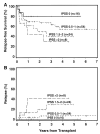Allogeneic hematopoietic cell transplantation for MDS: for whom, when and how?
- PMID: 22981712
- PMCID: PMC3509173
- DOI: 10.1016/j.blre.2012.08.002
Allogeneic hematopoietic cell transplantation for MDS: for whom, when and how?
Abstract
Hematopoietic cell transplantation (HCT) is currently the only treatment with curative potential for patients with myelodysplastic syndrome (MDS). However, treatment-related mortality and relapse have remained major barriers to uniform success. Therefore, important questions remain to be answered, such as whom to transplant, when and how. With reduced intensity conditioning (RIC) regimens, patients in their 70s and patients with comorbid conditions have been transplanted successfully, although the relapse incidence with this approach tends to be increased in comparison to high intensity regimens. Success rates are higher in patients transplanted at an early stage of their disease. Encouraging is the fact, that results with unrelated donors who are HLA-matched by high resolution typing are comparable to those achieved with HLA genotypically identical siblings. The establishment of cord blood as a source of stem cells, and the recent success with HLA-haploidentical related donors will allow the offering of HCT to virtually all patients. Dependent upon disease stage and characteristics, some 25% to 75% of transplanted patients will be cured. While 20%-30% of patients experience chronic medical problems after HCT, 70% report a "good to excellent" quality of life. New studies must focus on further reducing GVHD for all patients and on overcoming high relapse rates in patients with high risk disease.
Copyright © 2012 Elsevier Ltd. All rights reserved.
Figures


Similar articles
-
Allogeneic hematopoietic cell transplantation for myelodysplastic syndrome: current status.Arch Immunol Ther Exp (Warsz). 2012 Feb;60(1):31-41. doi: 10.1007/s00005-011-0152-z. Epub 2011 Dec 6. Arch Immunol Ther Exp (Warsz). 2012. PMID: 22143157 Review.
-
Current status of allogeneic hematopoietic cell transplantation for MDS.Curr Pharm Des. 2012;18(22):3215-21. doi: 10.2174/1381612811209023215. Curr Pharm Des. 2012. PMID: 22571701 Free PMC article. Review.
-
[Progress of research on allogeneic hematopoietic stem cell transplantation with reduced-intensity conditioning regimen for treatment of myelodysplastic syndrome - review].Zhongguo Shi Yan Xue Ye Xue Za Zhi. 2008 Aug;16(4):969-74. Zhongguo Shi Yan Xue Ye Xue Za Zhi. 2008. PMID: 18718102 Review. Chinese.
-
Alloreactivity as therapeutic principle in the treatment of hematologic malignancies. Studies of clinical and immunologic aspects of allogeneic hematopoietic cell transplantation with nonmyeloablative conditioning.Dan Med Bull. 2007 May;54(2):112-39. Dan Med Bull. 2007. PMID: 17521527 Review.
-
Allogeneic stem cell transplantation for adults with myelodysplastic syndromes: importance of pretransplant disease burden.Biol Blood Marrow Transplant. 2009 Jan;15(1):30-8. doi: 10.1016/j.bbmt.2008.10.012. Biol Blood Marrow Transplant. 2009. PMID: 19135940
Cited by
-
Impact of prior azacitidine on the outcome of allogeneic hematopoietic transplantation for myelodysplastic syndrome.Pathol Oncol Res. 2015 Sep;21(4):1037-43. doi: 10.1007/s12253-015-9933-8. Epub 2015 Apr 3. Pathol Oncol Res. 2015. PMID: 25837848
-
Some aspects of allogeneic stem cell transplantation in patients with myelodysplastic syndrome: advances and controversy.Stem Cells Cloning. 2014 Dec 4;7:101-8. doi: 10.2147/SCCAA.S50514. eCollection 2014. Stem Cells Cloning. 2014. PMID: 25506229 Free PMC article. Review.
-
Pre-transplant weight loss predicts inferior outcome after allogeneic stem cell transplantation in patients with myelodysplastic syndrome.Oncotarget. 2015 Oct 27;6(33):35095-106. doi: 10.18632/oncotarget.4805. Oncotarget. 2015. PMID: 26360778 Free PMC article.
-
Current therapy of myelodysplastic syndromes.Blood Rev. 2013 Sep;27(5):243-59. doi: 10.1016/j.blre.2013.07.003. Epub 2013 Jul 27. Blood Rev. 2013. PMID: 23954262 Free PMC article. Review.
-
[How I treat myelodysplastic symdromes].Zhonghua Xue Ye Xue Za Zhi. 2017 Apr 14;38(4):268-271. doi: 10.3760/cma.j.issn.0253-2727.2017.04.002. Zhonghua Xue Ye Xue Za Zhi. 2017. PMID: 28468085 Free PMC article. Chinese. No abstract available.
References
-
- Hamblin TJ. Epidemiology of the myelodysplastic syndromes. In: Bennett JM, editor. The Myelodysplastic Syndromes: Pathobiology and Clinical Management. Marcel Dekker, Inc.; New York, NY: 2002. pp. 15–27.
-
- Ma X, Does M, Raza A, Mayne ST. Myelodysplastic syndromes: incidence and survival in the United States. Cancer. 2007;109:1538–42. - PubMed
-
- De Roos AJ, Deeg HJ, Onstad L, et al. Incidence of myelodysplastic syndromes within a nonprofit healthcare system in western Washington state, 2005-2006. Am J Hematol. 2010;85:765–70. - PubMed
-
- Greenberg PL, Baer MR, Bennett JM, et al. Myelodysplastic syndromes: clinical practice guidelines in oncology [erratum appears in J Natl Compr Canc Netw. 2006 Mar;4(3):table of contents Note: dosage error in text] Journal of the National Comprehensive Cancer Network. 2006;4:58–77. - PubMed
-
- Gattermann N. Assessing the guidelines on iron chelation in MDS - where are we? [abstract] Leuk Res. 2009;33(Suppl. 1):S22–1. - PubMed
Publication types
MeSH terms
Grants and funding
LinkOut - more resources
Full Text Sources
Medical
Research Materials
Miscellaneous

